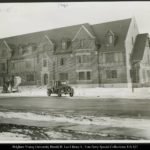
Aubrey Fairchild, a former BYU student who worked in the Amanda Knight Hall, said a hidden carving in the building hinted at “Amanda’s Treasure,” which was hidden somewhere in the attic above the cafeteria. Despite trying every janitorial key, Fairchild and her coworkers could never open the room.
While rumors of treasure remain unconfirmed, the Amanda Knight Hall still holds a treasure of a different kind: fond memories, according to assistant linguistics professor Troy Cox.
Amanda Knight Hall was constructed in 1939 as an all-girls dormitory and was named after Amanda Knight, the wife of university benefactor Jesse Knight, according to BYU Special Collections. Located on the south side of 800 North just east of University Avenue near Brick Oven, the building has hosted a variety of occupants over the years.
Amanda Knight Hall was converted into the first Provo Missionary Training Center and later housed the English Language Center and Senior Language Training for the MTC — a service that tutored senior missionaries and General Authorities on foreign languages, according to Fairchild.
BYU announced plans Jun. 30 to demolish Allen Hall and Amanda Knight Hall, two dormitory buildings dating back to the 1930s, citing safety risks and functional challenges. While Allen Hall was later torn down, Amanda Knight Hall is still standing, for now.
Last month, BYU put Amanda Knight Hall up for sale with the hope of finding investors willing to renovate the building — an undertaking that would likely cost about $10 million, according to a disclosure statement provided by University Communications.
However, if an investor doesn’t purchase the building, BYU will proceed with its plan to demolish it and construct a replica in its place — a move that would sidestep having to retrofit the current building for earthquakes, remove asbestos and lead paint, and install a central elevator to comply with the Americans with Disabilities Act.
Despite the high cost, David Amott, the programs director for Preservation Utah and a BYU alum, and local Provo neighborhoods have encouraged BYU to find an investor to renovate the building in a fashion similar to the Provo library renovations. Their efforts have been documented through their Facebook page, “Save Amanda Knight Hall at BYU.”
Amott said he and other community representatives spent time gathering petition signatures to show public interest in saving the building, which was on Provo’s Historic Landmarks Register until May 7, 2002, according to the Deseret News.
Amott said the building is representative of BYU’s ambition and growth over the years. According to Amott, Amanda Knight Hall was designed by twentieth-century architect Joseph Nelson and made to emulate the Gothic style of Ivy League universities.
“BYU was saying, ‘We are a school with ambitions to compete with the Ivy League. We want to put ourselves in the same category as Oxford and Cambridge,'” Amott said.
Amott said he has been appreciative of the university and President Kevin J Worthen’s willingness to listen to public feedback on the building.
“I don’t think everybody would be as concerned as President Worthen with public feedback, which is something we’re deeply appreciative of,” Amott said. “It can be hard for a large organization to go back and reconsider plans, but they’ve shown themselves willing to do that.”
Amott said he has reservations about the $10 million estimated price tag to renovate the building based on conversations with investors who have inspected it. Amott added he hopes developers would consider returning the building to its original purpose.
“All of the developers we’ve worked with think that a dormitory makes a great dormitory. The building was build as a dormitory and everyone seems to think that it could continue best in that capacity,” he said.
Amott said renovating the building would be preferred to a replica since Amanda Knight Hall, like other college dorms, stands as a “memory palace,” a thought echoed by Fairchild and Cox.
Fairchild said she and her coworkers at the Senior Language Center all grew close, like “a little family.” She also remembers eating lunch in the courtyard behind the building, which helped her escape from “the stresses of BYU.” Fairchild said a renovation could be “absolutely stunning.”
Cox also said he has fond memories of teaching there during the ’90s. He met his wife, Heidi Cox, while working as a visiting professor in the English Language Center. He enjoyed having access to a kitchen and attending cultural dance events in the building. However, he also noted some not-so-fond memories.
Cox said the building’s original wiring often struggled to keep up with the demand placed upon it. Students who were taking tests on computers would occasionally be interrupted by the circuit breaker going off, which interrupted exams. One time, a thunderstorm overloaded two computers and a printer.
“Imagine being a student, sitting shoulder to shoulder in a room with no air conditioning in the summer, and then the circuit breaks and you lose your paper and have to restart it,” Cox said.
He also noted the building was not friendly to students with disabilities, thanks to many stairs and the lack of an elevator. While the exterior of the building is beautiful, the inside is a cause for concern, Cox said — one reason why a replica or renovation of the building would be preferred, despite peoples’ memories.
“I think a replica would be outstanding, or I would love to see it retrofitted,” he said. “It’s easy to romanticize the past. Amanda Knight Hall was beautiful. Is the past more important than the future? I don’t know.”








